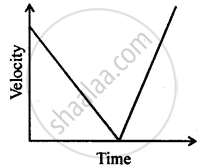Advertisements
Advertisements
Question
Two stones are thrown vertically upwards simultaneously with their initial velocities u1 and u2 respectively. Prove that the heights reached by them would be in the ratio of `"u"_1^2 : "u"_2^2` (Assume upward acceleration is –g and downward acceleration to be +g)
Solution
At the highest point, v = 0
For the sone thrown with velocity u1
`0 - "u"_1^2 = 2(-"g')h_1` (Using v2 − u2 = 2s)
or `"h"_1 = ("u"_1^2)/(2"g")`
Similarly for the stone thrown with velocity u2,
`"h"_2 = ("u"_2^2)/(2"g")`
∴ The required ratio, `"h"_1/"h"_2 = ("u"_1^2)/(2"g") xx (2"g")/("u"_2^2) = ("u"_1^2)/("u"_2^2)`
APPEARS IN
RELATED QUESTIONS
Which of the two can be zero under certain conditions : average speed of a moving body or average velocity of a moving body ?
Describe the motion of a body which is accelerating at a constant rate of 10 m s–2. If the body starts from rest, how much distance will it cover in 2 s ?
A cheetah starts from, rest, and accelerates at 2 m/s2 for 10 seconds. Calculate :
(a) the final velocity
(b) the distance travelled.
A body starts from rest and acquires a velocity 10 m s-1 in 2 s. Find the acceleration.
The velocity-time graph of a body in motion is a straight line inclined to the time axis. The correct statement is ___________
When is the positive acceleration?
Can you suggest a real-life example about the motion of a body from the following velocity – time graph?

How will the equations of motion for an object moving with a uniform velocity change?
An object starting from rest travels 20 m in the first 2 s and 160 m in the next 4 s. What will be the velocity after 7 s from the start?
An electron moving with a velocity of 5 × 104 ms−1 enters into a uniform electric field and acquires a uniform acceleration of 104 ms–2 in the direction of its initial motion.
(i) Calculate the time in which the electron would acquire a velocity double of its initial velocity.
(ii) How much distance the electron would cover at this time?
